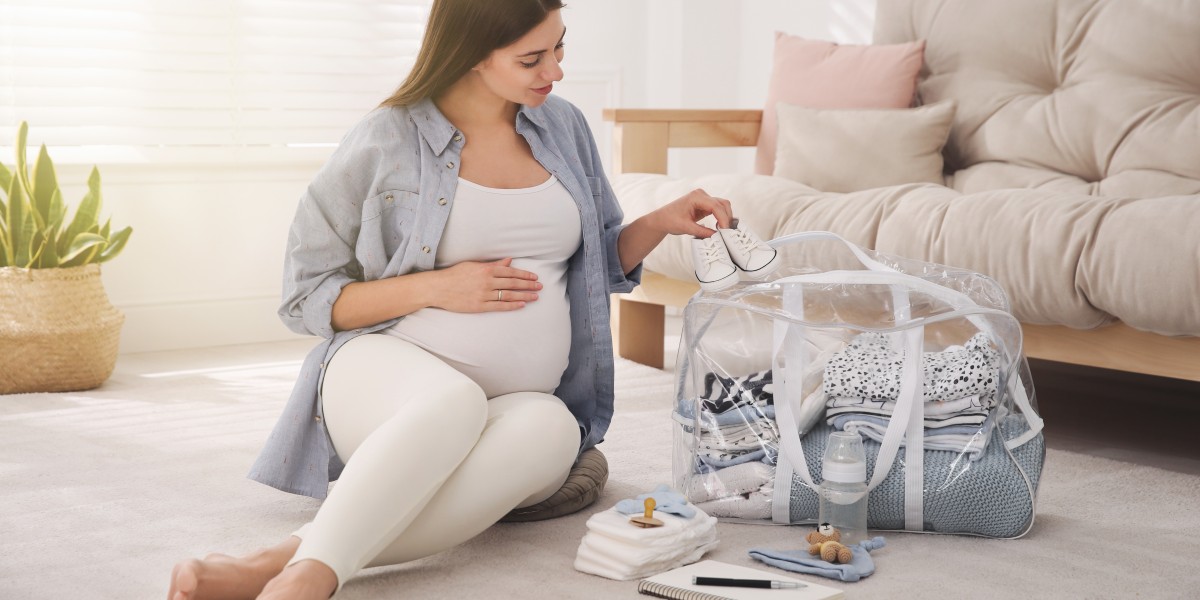
Parenthood is an amazing experience. It also comes with a new set of responsibilities... and financial challenges. Many Canadian parents choose to take a full 12-18 months of leave. Regardless of your situation, it’s likely that your income will be reduced for a period of time, which will impact how you cover your family’s expenses.
This reduction in income can create some anxiety to go with the excitement of parenthood. Thankfully, Canada’s Employment Insurance (EI) program includes maternity and parental benefits to help new parents make up for lost income while they’re away from work so they can cover their ongoing expenses (mortgage, groceries, etc.) and the costs of caring for a new child.
The EI maternity benefit can cover 55% of your earnings (up to a maximum of $650 weekly). However, not every new and expectant parent will be able to claim the full value of this benefit—and adding a new member to your family can be expensive.
Knowing how to budget for maternity leave is crucial for new and expectant parents. What are some of the costs that you have to budget for? How can you prepare for maternity leave? How can you apply for EI program benefits as a new parent to help you with your maternity leave?
Let’s discuss some of the basics about maternity and parental leave in Canada and how you can prepare for it financially to avoid needing to rely on credit to make it through the decrease in income.
How to Budget for Maternity or Parental Leave
The big question for many new and expecting parents is this: How should I manage my budget while taking time away from work? Dealing with the costs of a newborn while still taking care of regular monthly expenses can be a challenge. Here are a few steps to get you started.
Step 1: Start Preparing for Reductions in Pay
Employers in Canada aren’t generally required to pay for maternity leave. They may need to provide leave to new parents, but they don’t necessarily have to provide pay during this time off. Although the EI’s maternity benefit helps offset this loss of income, it’s not a total replacement and not everyone is eligible.
So, expecting parents will need to ensure that their maternity or parental leave budget accounts for this potential reduction in income.
Step 2: Set Up Your “Baby Fund”
One thing that can help is having an emergency fund in place well before baby arrives. This is especially important if your workplace doesn’t offer maternity/paternity leave pay.
How much should you set aside for this baby fund? Start by researching prices for childcare and products in your area to better understand what you can expect to spend on the first few months of care for your newborn. It’s helpful to do this research after you know you’re expecting because prices change all the time, and some products may experience shortages that make them harder (and thus, more expensive) to acquire.
So, be sure to do some independent market research and make adjustments to your budget plan as needed.
Step 3: Apply for EI Maternity/Parental Benefits
When you’re expecting it can help to apply for EI maternity and parental benefits prior to the birth. You can receive maternity benefits as early as 12 weeks before your “due” date for the baby and parental benefits can start the week your child is born (or adopted).
When applying for benefits, it can help to apply for both parental and maternal benefits at the same time and simplify the process overall.
Maternity benefits are available for up to 15 weeks to the person who cannot work because they're pregnant or have recently given birth. They cannot be shared between parents.
Both parents can share parental benefits, but must choose the same option when applying. What are these options?
The two parental benefit options are:
- Standard Parental Benefits. These benefits are valued at up to $638/week for a maximum of 35 weeks.
- Extended Parental Benefits. These benefits cover up to $383/week for as many as 61 weeks.
The extended parental benefit pays slightly more over time than the standard benefit ($23,363 over 61 weeks vs $22,330 over 35 weeks). However, the standard benefit may be better for situations where you have higher short-term costs or expect to return to work within the first year.
To apply for EI maternity and parental benefits, you’ll need to gather some personal information and documents, such as:
- The names and addresses of your employers for the last 52-week period
- Dates you were employed with each employer
- If applicable, the reason for leaving prior employment and an explanation of the facts behind the termination of employment (voluntary or involuntary)
- Your full mailing and home address
- Your social insurance number (SIN)
- The SIN of any other parent you’re planning to share benefits with
- Banking information for direct deposit
- The expected (or actual) date of the child’s birth (or adoption placement date, if applicable)
After collecting this information, you can apply for parental/maternity benefits online and submit your required documents via mail or by dropping them off at a Service Canada Centre.
Step 4: Start Tracking Your Expenses
Once you’ve applied for the applicable benefits and know how much you will be receiving versus your expected costs, it’s time to start crafting your maternity leave budget. However, you may be surprised to notice that your actual spending varies somewhat from what you thought.
Here, using a tool like a Budget Planner + Expense Tracker to assemble your budget and start tracking how much you spend (and on what) can be incredibly helpful. Seeing where you’re spending money, and how much, can help you identify unnecessary costs so you can cut back and take a more informed and deliberate approach to managing your finances.
Sometimes, simply seeing what you’re spending versus what you’re earning can help you avoid making impulse buys that leave you short of cash for more essential costs like food, mortgage/rent, and clothing for your newborn or paying down debt so it can’t build up to uncontrollable levels.
Some examples of things you might want to consider to help curb spending include pausing gym memberships, eliminating some streaming services that you aren’t actively using, or avoiding eating out to focus on making home-cooked meals. Have a friend or family member who wants to help? Consider asking them to provide meals to stash away in the freezer.
Step 5: Consider Buying Used
Baby clothing can be more expensive than you might initially think. Especially when baby grows up so quickly that they need new clothes every few weeks. Baby equipment can also be costly. One way to reduce these expenses is to buy used instead of new. There are many parents out there who have baby clothes, cribs, and other accessories that they no longer need.
So, by hitting up garage sales, approaching your friends with children who have outgrown their baby cribs, and goodwill stores that offer secondhand baby clothing, you can potentially save a significant amount of money on the necessities for your new child.
How Much Does Having a Baby Cost?
To budget for a major life event like having a baby or adopting a child, it’s important to know what the associated costs are. So, how much does having a baby cost in Canada? While our healthcare system covers most costs for Canadian residents, there may be some financial responsibility for services that may vary from province to province.
Most birth-related care for a Canadian resident in a hospital with healthcare coverage is extremely affordable—Residents often pay just a few hundred dollars for delivery depending on their province. Visitors, on the other hand, may end up paying upwards of $10,000 for prenatal care and delivery services.
How Much Will Caring for a Newborn Cost after Leaving the Hospital?
The next step in budgeting for maternity leave is understanding how your expenses are going to change. New parents need to consider:
- Diapers. You’d be surprised just how many diapers a baby can go through in a month; at an estimated 10 diapers/day, a baby can easily use up more than 300 diapers per month. How much this will cost you will depend on the diaper brand you choose and where you buy it from, but average diaper prices can vary between $0.16 and $0.32 per diaper, so that’s between $48 and $96 a month for the average family.
- Wipes. Costs may vary depending on the brand of wipes you use, where you buy them, and how many wipes you use each time. So, it’s hard to generalize about this cost. A 560 pack of wipes (10 packs of 56 wipes each) costs about $19.97-$23.49 on an online retail site such as Amazon—making each wipe cost about $0.035 to $0.042. If you use two wipes per diaper change, you could go through 600 wipes/month, making your average cost per month between $21.40 and $25.17.
- Baby Clothes. Babies grow up so fast—meaning that they’ll be in constant need of new clothes. The cost of baby clothing varies greatly, so it can be hard to estimate. Recommendations vary, but five to eight bodysuits, four pairs of pants, a set of pajamas for each day of the week, five pairs of socks, and two or three hats should be enough for most newborns to be comfortable and fashionable. Then, as the baby grows, you’ll need to replace each item. Baby showers can help with this expense, as can using hand-me-downs from friends and family.
- Baby Formula. If you intend to use formula, costs will vary depending on brand, feeding frequency, and where you buy, so it’s hard to generalize about the costs, but you could be looking at up to $400 per month.
- Baby Stroller. Stroller costs can vary wildly, but you can easily spend more than $120 just for a “basic” model at your local superstore, with many parents choosing brands that cost upwards of $1,500.
- Toys. Baby toys can help new parents keep their newborns focused on interacting with safe and educational objects so they don’t accidentally hurt themselves. How much you spend on toys for baby will vary greatly depending on the kinds of toys you buy and where you shop.
- Childproofing Equipment for the Home. Since toddlers can be so incredibly curious, it’s important to add some childproof safety equipment to the electrical fixtures, cabinets, and other items around your home. Estimates vary—especially since the layout of your home can play an enormous factor in your childproofing costs—but “general babyproofing” can cost between $139 and $554.
- Crib and Other Furniture. One of the more considerable upfront baby expenses for many Canadian families is furniture for their newborn. Infants will need things like cribs, baby seats, protective car seats, and more as soon as you leave the maternity ward—and the costs for these things can be high, reaching into the hundreds (and even thousands!) for each item.
The above list covers many of the basic costs of caring for a newborn. However, if you choose to use childcare services so you can return to work sooner, that can add over a thousand dollars per month to your costs.
Eventually, you’ll also need to start considering the costs of solid food, a wider variety of clothing, school costs (supplies, club/sports expenses, etc.), and more.
Need help with managing your new baby budget? Reach out to Credit Canada for assistance. Our certified credit counsellors can provide a wealth of budgeting tips and resources to help you get out of debt so you can focus on nurturing that new life!

Frequently Asked Questions
Have a question? We are here to help.
What is a Debt Consolidation Program?
A Debt Consolidation Program (DCP) is an arrangement made between your creditors and a non-profit credit counselling agency. Working with a reputable, non-profit credit counselling agency means a certified Credit Counsellor will negotiate with your creditors on your behalf to drop the interest on your unsecured debts, while also rounding up all your unsecured debts into a single, lower monthly payment. In Canada’s provinces, such as Ontario, these debt payment programs lead to faster debt relief!
Can I enter a Debt Consolidation Program with bad credit?
Yes, you can sign up for a DCP even if you have bad credit. Your credit score will not impact your ability to get debt help through a DCP. Bad credit can, however, impact your ability to get a debt consolidation loan.
Do I have to give up my credit cards in a Debt Consolidation Program?
Will Debt Consolidation hurt my credit score?
Most people entering a DCP already have a low credit score. While a DCP could lower your credit score at first, in the long run, if you keep up with the program and make your monthly payments on time as agreed, your credit score will eventually improve.
Can you get out of a Debt Consolidation Program?
Anyone who signs up for a DCP must sign an agreement; however, it's completely voluntary and any time a client wants to leave the Program they can. Once a client has left the Program, they will have to deal with their creditors and collectors directly, and if their Counsellor negotiated interest relief and lower monthly payments, in most cases, these would no longer be an option for the client.







